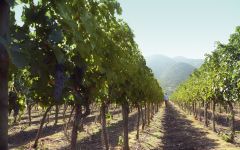Vina Tarapaca Gran Reserva Cabernet Sauvignon 2014
- Decanter
-
James
Suckling -
Wine
Spectator



Product Details
Your Rating
Somm Note
Winemaker Notes
Professional Ratings
-
Decanter
Fresh strawberry and plum aromas. Very pure fruit, supported by the oak which stays well out of the way. Elegant!
-
James Suckling
A red with stone, spice and fresh tobacco character. Full body, dark fruit with stone undertones and a juicy finish. Bright and fresh. Drink now or hold.
-
Wine Spectator
A firm and pure-tasting red, with graphite and slate notes to the dried plum and cherry tart flavors. Licorice snap and bittersweet chocolate details show on the finish.
Other Vintages
2020-
James
Suckling -
Wine
Enthusiast -
Wine
Spectator
-
James
Suckling
-
James
Suckling -
Wine
Enthusiast
-
James
Suckling -
Wine
Enthusiast -
Wine &
Spirits
-
James
Suckling
-
James
Suckling
-
James
Suckling









Since Viña Tarapacá was founded in 1874 by Don Francisco de Rojas y Salamanca at the foothills of the Andes mountain range, it has crafted elegant, quality wines, becoming one of the most traditional and historical Chilean wineries, as well as a benchmark for viticulture in Chile and over 50 countries.
Viña Tarapacá has achieved important and consistent acknowledgements since 1876 due to its winemaking heritage and experience in pursuit of quality and excellence.
Being part of VSPT Wine Group, it has a strong sense of environmental friendliness, adhering to the highest international quality standards and certifications. VSPT became Green Company of the Year in the 2016 Green Awards -the competition’s maximum prize- as well as being recognized as leader in Renewable Energy Implementation, thanks to its firm commitment to sustainability.

A noble variety bestowed with both power and concentration, Cabernet Sauvignon enjoys success all over the globe, its best examples showing potential to age beautifully for decades. Cabernet Sauvignon flourishes in Bordeaux's Medoc where it is often blended with Merlot and smaller amounts of some combination of Cabernet Franc, Malbecand Petit Verdot. In the Napa Valley, ‘Cab’ is responsible for some of the world’s most prestigious, age-worthy and sought-after “cult” wines. Somm Secret—DNA profiling in 1997 revealed that Cabernet Sauvignon was born from a spontaneous crossing of Cabernet Franc and Sauvignon Blanc in 17th century southwest France.

The Maipo Valley is Chile’s most famous wine region. Set in the country’s Central Valley, it is warm and quite dry, often necessitating the use of irrigation. Alluvial soils predominate but are supplemented with loam and clay.
The climate in Maipo is best-suited for ripe, full-bodied reds like Cabernet Sauvignon (the region’s most widely planted grape), Merlot, Syrah and Carmenère, a Bordeaux variety that has found a successful home in Chile.
White wines are also produced with great prosperity, especially near the cooler coast, include Chardonnay and Sauvignon Blanc.
